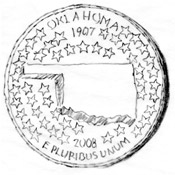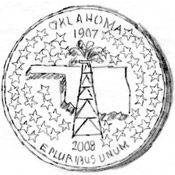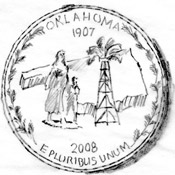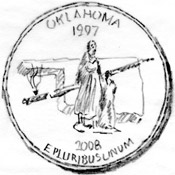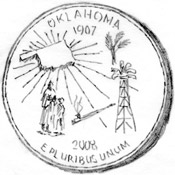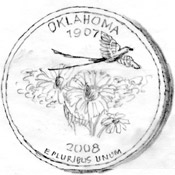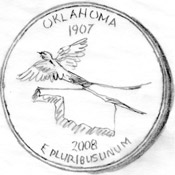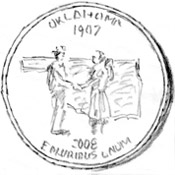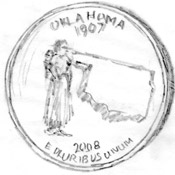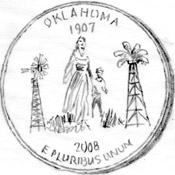Papa was a compulsive builder. he went on building binges the way an alcoholic goes on drinking sprees. When the urge to construct came over him he was powerless to resist. Appeals to reason were useless. The shortage of money didn't deter him. Nor did the nonessential nature of what he planned to build. When the building bee bit him he got a look in his eye, a tenseness in his body. He was a slave to this uncontrollable habit....
After the Big House and the original barn, Papa conceived the lake and the bathhouse and the silos. Then he dug a deep water well and installed a vast underground network of pipes wihch brought running water to most of the houses and buildings on the ranch. When the water didn't run, it walked. Often it stopped entirely when the electric pump broke down.
After the silos, Papa dreamed up the chicken houses (which covered half an acre) and the Dance Pavilion and the tourist camp. Then came service station No. 1 (with a two-story house attached) and the tavern (with a five-room apartment in the rear) and service station No. 2.
These were his major works, his symphonies. In between them, Papa kept himself tuned up by building houses. Along WPA Row, he built six tenant houses, each with a wood-burning fireplace and a native stone outhouse. (This row of houses got its name during Depression days when Papa had his own private WPA setup, inspired by and fashioned after the government's relief program.)...
Just as a musician has his favorite motif so did Papa have his. It was building with rock. Only he didn't call it "rock"; he called it "natural stone." All of his creations, beginning with the huge, two-story Big House and ending with the wall around the lake, were built with the rocks which were so abundant on the ranch. Papa often pointed to the hill across the highway and said, "There's enough natural stone there to build a dozen cities!" (He, of course, would be the builder of them all.) He had his own rock quarry where the stones were shaped, trimmed, and cut to size. Some of his walls were made from dark, moss-covered, unchiseled stone; others were faced with quarried rock of a light sandstone color. Papa called natural stone the perfect building medium. It never had to be painted and it stood the years perfectly....
A few yards from the Dance Pavilion, situated on a quiet little dirt road leading to the highway, was Papa's tourist court. Built long before the word "motel" was coined, these cottages of Papa's caught the eye of the tourist. Ernie Cooper had built them from his loveliest quarried sandstone. Their gabled roofs were covered with bright green shingles. Each cabin contained two bedrooms, a kitchenette, a bath, and a back porch. True, the bath wasn't tiled, the kitchenette wasn't equipped, and the beds sagged. Still, Papa could proudly proclaim (and he did): "There's not another tourist court in the whole U.S.A. with a wood-burnin' fireplace in every unit!"
The tourist court surprised everybody, including Papa, by turning out to be a good investment. During World War II all six houses were rented by the month to workers of the Douglas plant in Tulsa. Papa preferred "family people" to overnight trade. He lacked the temperament of an innkeeper. He worried too much about people's morals, motives, and emotions. "I can't stop thinkin' about what's goin' on in each one of 'em," he admitted.
The tourist court was not rented during one of my summer vacations from college. I wante dto run it to make some money. My brother was defying the Depression with his operation of the tavern on a snob basis. Up and down the road in both directions he placed signs saying: Welcome Harvard, Welcome Yale, Welcome Dartmouth, and Welcome Princeton. He figured that if anyone in America had any money left to spend, it would be an alumnus of one of these Eastern schools who was driving through Oklahoma. He was right. Ivy Leaguers saw the signs and stopped for food. He even extended his sign campaign to include Welcome Williams, Welcome Notre Dame, and Welcome Big Ten.
The snob approach worked in the tavern, but it wouldn't work in the tourist court. You couldn't expect a snob to pay his money to sleep on one of those dreadful mattresses. So I decided to charge bargain rates and settle for the common people.
Papa was opposed to my running the tourist court. He tried every way he could to discourage me.
"I know the score, Papa," I assured him. "I'm in college, remember?"
Papa wasn't sold on the idea yet. "I know you can do it, Sonny, but I ain't so sure I want you to do it. U'see, many people who want to stay in the tourist cour aren't really tourists. I mean -- well, you've gotta take the bitter with the sweet, and --" He could see that being delicate was getting him nowhere. He decided to lay the cards on the table.
"Pull up a chair and sit down!"
I pulled up a chair and sat down.
"Now, Son, I'm gonna let you run the tourist court this summer because your brother has the tavern and you can use some money, too. But somebody's gotta tell you what you have to know, so it might as well be your old Dad. Rule One: Always have plenty of hot water."
"But Papa! When it's a hundred degrees outside, a person doesn't --"
"In college, huh? Do as I say. Always have hot water. You'll lose half your customers if you don't have it."
Now that he was launched, Papa threw himself wholeheartedly into his indoctrination course. "Rule Two: Some people get tired drivin' and want to rent a cabin for maybe just an hour or two to get a little rest. Don't look at 'em like you don't believe 'em. Keep still and mind your own business."
"Rule Three: Some of the people who look the tiredest from drivin' will have license plates from our own county. If they pay in advance, you've gotta believe 'em when they say they're tired!
"Rule Four: When ten couples in a row register as 'Mr. and Mrs. John Smith,' don't make any wisecracks. It's a very common name.
"Rule Five: Nobody ever got into trouble by keepin' his mouth shut."
He took a deep breath.
"Sonny boy, it's a degradin' kind abusiness. Bein' exposed to it can make you tough if you're not strong. But I know my son! You're gonna see what's wrong and you're gonna know what's right and you're not gonna let the wrong kinda people influence your life!"
That was as close as Papa ever came to telling me the Facts of Life. I soon found that with a tourist court I didn't need any further instruction.
